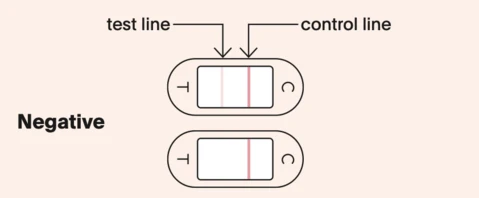Does a Faint Line on an Ovulation Test Mean Ovulation is Coming?

Dr. Gleaton breaks down the difference between the faint line on pregnancy tests versus ovulation tests.
Double lines on a pregnancy test may indicate a positive result, but ovulation test results are a little different. Let’s discuss what that faint line means, and how to tell when you’re really ovulating.
Why use an ovulation test?
If you’re trying to get pregnant, ovulation tests and ovulation kits are helpful for identifying when your ovaries are going to release an egg so you can make sure it gets a welcoming (or fertilizing) committee. Eggs can only live for up to a day after they’re released, so it’s extremely important you have sex before and during ovulation to optimize your chances of getting pregnant. Using an ovulation predictor kit (OPK) ensures you don’t miss this window.
What does a faint line mean?
If you have experience with analog pregnancy tests, you probably know that double lines, no matter how faint, mean a positive result. It can be a little more complicated knowing how to read an ovulation test—but as long as you follow the instructions carefully, you’ll get the hang of it in no time.
The hormone that ovulation tests are looking for, luteinizing hormone (LH), peaks right before ovulation, but is present throughout your menstrual cycle. A lighter line on ovulation test results means a little LH was detected, but not enough to indicate an LH surge which happens right before ovulation. So what does no LH surge mean? If you don’t see this surge, you might have tested at the wrong time or ovulated earlier or later than usual.

So is a faint positive ovulation test pregnant or not pregnant? Well, this is a trick question. A positive ovulation test result will not have faint lines. As you approach ovulation, which increases your chances of getting pregnant, the line usually gets darker until a positive test result appears, like this:
LH levels throughout your cycle
In addition to helping identify your fertile window, ovulation testing can be helpful to uncover patterns that may make it difficult to get pregnant.
High LH levels (when you aren’t ovulating anytime soon) could indicate:
- Perimenopause or menopause: If you’re over 40 and have consistently high LH levels, it’s possible you aren’t ovulating at all due to menopause. Read more about signs of perimenopause.
- Polycystic ovary syndrome (PCOS): PCOS is a common hormone disorder affecting childbearing women and a leading cause of female infertility. Women with PCOS often have high levels of LH, and often don’t ovulate.
Low LH levels (when you should be ovulating) may indicate:
- Problems with your pituitary gland
- Disordered eating or malnutrition
- High stress
You should absolutely talk to your doctor if you have concerns about your LH tests. Your doctor can run additional tests (including a blood LH test) to determine what, if anything, is going on.
What does a line as dark or darker than the control line mean?
When your test line is as dark or darker than the control line, you have a positive OPK, and you’ll likely ovulate within 24-48 hours! If you want to get pregnant this month, now is the time to have sex.
Make sure you know how often you should have sex during ovulation so that you can further increase your chances.

What if I never see a positive line?
Feel like you’ve been ovulation testing forever with no signs of a positive in sight? It’s possible that you have ovulated early or late in your cycle and missed your window. Try starting earlier in your menstrual cycle next month, and keep testing until you get a positive. If you keep seeing negative results, talk to your OBGYN or consider seeing a fertility specialist.
Things to keep in mind when taking ovulation tests
To ensure an accurate result, make sure you:
- Haven’t urinated for at least two hours.
- Haven’t overhydrated; consuming too much liquid can dilute your urine and cause a false-negative result.
Some things to consider:
- If you have PCOS, primary ovarian insufficiency, or another hormonal medical condition: Your ovulation test results could be skewed.
- If you have an irregular or missed period: It’s possible that you might not ovulate each cycle, so you might not see a positive result when you expect to.
If you have questions about our at-home ovulation test results, you can always reach out to us. If you’re concerned about your results, talk to your doctor.
Takeaways
- Ovulation tests help you predict your fertile window so that you can time sex for pregnancy.
- If you have a fairly regular cycle, you should see a higher LH level right before ovulation and a lower LH level during the rest of your cycle
- You want to base your test line off of the control line. A test line that is as dark or darker than the control line indicates that ovulation will occur within the next 24-48 hours
Reach Out, We're Here
Have questions about your order or products? For the speediest answer, check out our FAQ section. Need something else? Come find us below.
Please keep in mind our regular business hours; Monday-Friday, 9am-5pm CT.
Customer Support
support@natalist.com
Press Inquiries
media@everlyhealth.com
Business & Partnerships
team@natalist.com
Affiliates + Influencers
team@natalist.com
Job Openings
Careers Page

























